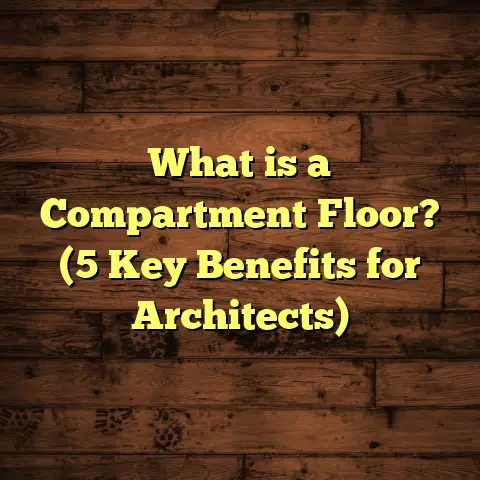What is Cheaper: Hardwood Floor or Tile? (5 Key Cost Factors)
Myth: Hardwood floors are always more expensive than tile.
I hear this quite often when chatting with homeowners, and honestly, it’s a bit misleading. The truth is, the cost comparison between hardwood and tile flooring isn’t black and white. Sometimes hardwood comes out cheaper; other times, tile takes the lead.
Over the years, having worked on countless flooring projects—both as a contractor and a consultant—I’ve realized that many factors come into play when figuring out what really costs more. And by “cost,” I mean not just the upfront price but everything that goes into installation, maintenance, and long-term value.
Let me walk you through what I’ve learned so far.
What is Hardwood Flooring and Tile Flooring?
Before we jump into numbers and comparisons, let me clarify what hardwood and tile flooring actually are. This will help us understand why their costs vary so much.
Hardwood Flooring
Hardwood flooring is made from solid wood planks cut from trees like oak, maple, walnut, or cherry. It’s a natural product, prized for its warm look and ability to add character to a home. Hardwood floors can last for generations if cared for properly.
There are two main types of hardwood floors you’ll hear about:
- Solid Hardwood: This comes as thick planks (usually ¾ inch thick) of one solid piece of wood. It can be sanded and refinished multiple times.
- Engineered Hardwood: These are thinner layers of real wood glued over plywood or fiberboard. While they look like solid hardwood from the top, they have less sanding potential.
For this discussion, I’m focusing mostly on solid hardwood since it’s the classic choice people usually mean when they say “hardwood floor.”
Hardwood flooring is often installed in living rooms, bedrooms, hallways—anywhere homeowners want that cozy, upscale feel.
Tile Flooring
Tile flooring typically refers to ceramic or porcelain tiles made from natural clay baked at high temperatures until hard. Tiles come in all sorts of colors, shapes, patterns, and sizes—from simple square ceramic tiles to intricate mosaic porcelain designs.
Tile is known for its durability and resistance to moisture, making it popular in bathrooms, kitchens, basements, and even outdoor spaces.
There’s also natural stone tile (like marble or slate), but those usually cost more and require specialized installation.
How Are They Different?
- Material Source: Hardwood is organic wood; tile is mineral-based ceramic or porcelain.
- Feel Underfoot: Hardwood has warmth and softness; tile feels cooler and harder.
- Installation Methods: Wood planks are nailed or glued; tiles are set with mortar and grouted.
- Maintenance: Hardwood needs refinishing; tiles need grout cleaning/sealing.
Knowing these basics sets us up well to talk about what drives cost differences.
1. Material Costs: What Are You Really Paying For?
When I first got into flooring work, I was amazed at how much material costs could shift depending on choices. It’s not just hardwood vs. tile—within each category are huge price ranges.
Hardwood Material Pricing
Hardwood prices depend heavily on:
- Species: Oak is usually the cheapest common wood ($3-$5/sq ft). Harder woods like maple or hickory run $4-$7. Exotic woods like Brazilian cherry can top $10 or more.
- Grade: Clear grade wood (fewer knots) costs more than rustic or character grades.
- Finish: Prefinished wood floors cost more upfront but save installation time.
If you’re thinking about hardwood floors for your house, expect to pay roughly between:
$4 and $8 per square foot just for the wood.
I remember a job where a homeowner wanted solid oak hardwood floors installed throughout a 1,200 sq ft house. The wood itself was about $4.50/sq ft. That came out to around $5,400 just in materials.
Tile Material Pricing
Tile varies by type:
- Basic ceramic tiles: Often the cheapest option at $1 – $3 per square foot.
- Porcelain tiles: Denser and more durable; typically $3 – $8 per square foot.
- Natural stone (marble, granite): Premium materials costing anywhere from $7 to over $20 per square foot.
Tile prices also depend on style complexity. Large-format or designer tiles cost more than standard squares.
For example, a 300 sq ft kitchen tiled with mid-range porcelain might have tile costs around $5/sq ft or $1,500 total.
What I’ve Learned
Material-wise, tile generally starts cheaper than hardwood—especially ceramic—but high-end porcelain or stone can match or exceed hardwood prices.
So if you’re on a tight budget but want durability in a kitchen or bathroom, tile materials might be your best bet. But if you want that classic look in living areas, hardwood material investment might be worth it.
2. Installation Costs: Labor Time Adds Up Fast
Material costs only tell part of the story. Labor is often the bigger chunk of your total floor project cost.
Hardwood Installation
Installing hardwood requires skill and time:
- The subfloor must be level and clean.
- Planks are nailed or glued down carefully.
- Boards need precise cutting around corners and doors.
- Sanding (for unfinished floors) and finishing add extra steps.
Labor rates vary by region but generally run between:
$4 and $8 per square foot
For my oak floor project mentioned earlier (1,200 sq ft), labor came out to about $6/sq ft or $7,200 total.
Tile Installation
Tile installation is different but also labor-intensive:
- Surface prep includes waterproofing in wet areas.
- Tiles are set with mortar and spacers.
- Grouting takes careful work.
- Cutting tiles (especially porcelain) requires special tools and patience.
Labor usually costs:
$5 to $10 per square foot
Tile labor can be pricier depending on pattern complexity or if there are lots of cuts around cabinets or fixtures.
Personal Take
I’ve installed both floors numerous times. Generally:
- Tile installation takes longer per square foot because every tile needs placement, leveling, spacing, grouting.
- Hardwood installation is quicker per sq ft but may require more prep work if the subfloor needs fixing.
In some cases, tile labor costs can double hardwood labor costs—especially with fancy patterns or mosaics.
3. Durability and Maintenance: How Much Will You Spend Later?
Many homeowners focus on upfront costs but forget maintenance over time.
Hardwood Maintenance Costs
Hardwood floors last decades but need care:
- Regular sweeping/vacuuming.
- Avoid water spills to prevent warping.
- Refinishing every 7–10 years ($2-$4/sq ft) to remove scratches and restore shine.
If you have kids or pets like I do, hardwood can get scratched faster—and refinishing costs add up over time.
Tile Maintenance Costs
Tile wins here for ease:
- Tiles are easy to mop clean.
- Grout lines need sealing every few years ($1-$2/sq ft).
- Tiles rarely crack unless heavy objects drop on them.
- No refinishing needed; just basic upkeep.
For bathrooms and kitchens especially, tile maintenance is far less demanding than hardwood.
Experience Speaks
I once helped a client who installed hardwood in their kitchen against my advice—they loved the look but ended up spending hundreds extra fixing water damage after spills soaked into the wood. If they’d gone with tile, they’d have saved money in repairs long term.
4. Waste Factor: Don’t Forget Extra Material Costs
Here’s something many people overlook—how much extra flooring material do you need to order?
Waste With Hardwood
Wood planks come in fixed lengths. Cutting for corners and odd shapes creates waste—but you can often use scrap pieces elsewhere (like closets).
Typical waste factor: 5–10%
For a 1,000 sq ft room, buy about 1,050–1,100 sq ft of hardwood material.
Waste With Tile
Tile waste tends to be higher because:
- Tiles break during shipping or cutting.
- Complex room shapes require more cuts.
- Pattern matching may require ordering extra to avoid mismatches.
Typical waste factor: 10–15%
For 1,000 sq ft tiled room, order 1,100–1,150 sq ft of tile material.
This adds directly to your costs upfront but prevents delays needing more orders later.
5. Resale Value: How Does Flooring Affect Your Home’s Worth?
Flooring can influence how much buyers will pay for your home.
Hardwood Floors Add Value
Hardwood floors are often seen as a premium feature:
- Studies show homes with hardwood floors sell for about 1–2% more than similar homes without.
- Hardwood floors are timeless; they rarely go out of style.
- Can be sanded/refinished multiple times to restore beauty.
Many buyers specifically seek homes with hardwood in living rooms and bedrooms.
Tile Floors’ Impact
Tile adds value mainly in bathrooms or kitchens:
- Buyers appreciate durable and water-resistant flooring there.
- However, tile styles can date faster compared to hardwood.
- Some buyers prefer hardwood over tile in main living spaces for warmth.
While tile adds value in wet areas, hardwood usually has a slight edge for overall resale value across the whole house.
Personal Stories From The Field
Let me share a couple stories from my years working with clients on flooring choices:
Story 1: The Kitchen Reno Surprise
A couple hired me to install porcelain tile in their kitchen because they wanted durability and easy cleanup. They picked mid-range tiles around $4/sq ft with complicated herringbone pattern.
Material plus labor ran higher than expected—labor alone was $9/sq ft due to pattern cuts. Total project cost topped $12k for a 1,200 sq ft kitchen-living combo area.
They loved tile’s look and durability but told me afterward that if they had been more realistic about labor costs or chosen simpler patterns/materials, they could have saved thousands without sacrificing quality.
Story 2: Living Room Warmth Wins Out
Another client wanted hardwood throughout their 2,000 sq ft home for that warm feel. We chose red oak at about $5/sq ft material cost plus $6 labor/sq ft. Total project cost was roughly $22k including waste factor and finishing.
They said it felt like a good investment because the floor added warmth and character—plus buyers later told them hardwood was a big selling point when they put the house on market years later.
Data Snapshot: Average Cost Comparison for 1,000 Sq Ft Room
| Item | Hardwood Floor | Tile Floor |
|---|---|---|
| Material Cost | $4,000 – $8,000 | $1,000 – $8,000 |
| Labor Cost | $4,000 – $8,000 | $5,000 – $10,000 |
| Waste Factor | 5 – 10% extra | 10 – 15% extra |
| Maintenance Over 10 years | $500 – $2,000 (refinishing) | $200 – $600 (grout seal) |
| Resale Value Impact | +$5,000 – $10,000 approx | +$2,000 – $6,000 approx |
Common Questions About Hardwood vs Tile Costs
Q: Does DIY installation save money?
A: Yes—but only if you’re skilled! Installing hardwood requires precision; mistakes can be costly. Tile installation demands special tools (wet saws) and patience. For most homeowners without experience, professional installation is safer long term.
Q: What about underfloor heating?
A: Tile is better for radiant heat because it conducts heat well. Hardwood can warp if exposed to excessive moisture/heat changes. Adding radiant heating under either increases installation costs significantly (upwards of $5/sq ft).
Q: Which flooring lasts longer?
A: Both can last decades if maintained properly. Hardwood can be refinished multiple times; tile rarely needs replacement but grout lines can degrade over time needing resealing or touch-ups.
Using Tools To Get Accurate Estimates
When I help clients estimate costs these days, I often use online tools like FloorTally. It lets you plug in your room size,
choose materials,
and see local labor rate estimates instantly.
This helps avoid surprises later when quotes vary wildly between contractors or suppliers.
It also factors in waste percentages automatically—something many forget when budgeting!
Wrapping Up: Which Flooring Is Cheaper?
If you’ve stuck with me this far—thanks! Here’s how I’d sum it up based on everything above:
| Factor | Hardwood | Tile |
|---|---|---|
| Upfront Material | Mid to high cost | Low to high cost depending on type |
| Labor | Moderate | Often higher |
| Maintenance | Periodic refinishing needed | Low maintenance |
| Waste | Lower waste | More waste |
| Resale Value | Higher potential | Good in wet areas |
Final thought: If budget is your only concern for wet areas like kitchens/baths,
tile usually wins upfront due to cheaper materials despite higher labor.
But if you want beautiful living spaces that add lasting value,
hardwood often pays off better long term—even if initial price seems higher.
I’ve seen both options succeed brilliantly depending on homeowner goals,
preferences,
and project specifics.
Got a specific project? Share your details—I’m happy to help crunch numbers based on your exact needs!
practical examples,
giving you a comprehensive view on the true cost differences between hardwood and tile flooring.





